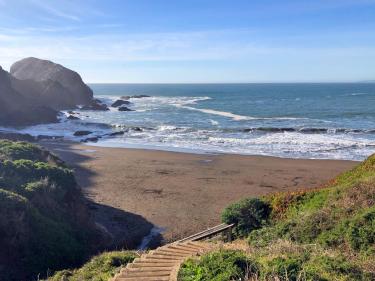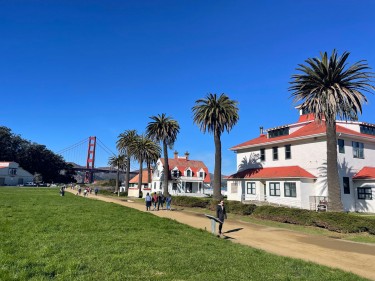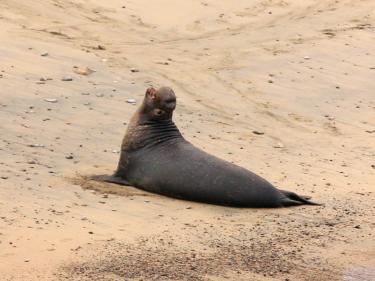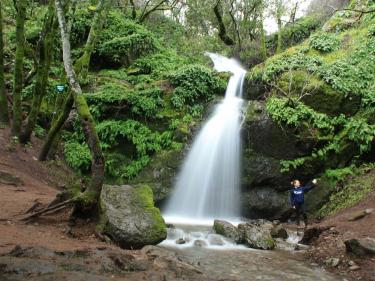Watching the Salmon of Lagunitas Creek

hile many think of heading out to Point Reyes for whale watching in the winter, it's also possible to get a glimpse of another fascinating aquatic creature in Marin County: the coho salmon. Winter, from approximately late November through February, is spawning season for the endangered coho salmon, and West Marin's Lagunitas Creek is home to one of the largest populations of wild coho in California. There are several places along the creek where you can view these magnificent fish on their final journey upstream.
January is one of the best times to go look for coho in Lagunitas Creek, especially a few days after a rainstorm. Salmon can range in size from two to three feet, and the spawning males turn a bright red color and develop a hooked upper jaw called a "kype." Spawning female coho are a darker, more muted red with a white tail. Salmon fresh from the Pacific which haven't yet developed their spawning colors are a gray or olive color. You may also see steelhead trout in the creek; both male and female steelheads are silver with black-spotted backs and pink stripe down the side.
Coho salmon spend the majority of their lives in the Pacific Ocean, but travel back to the freshwater streams where they were born to spawn. After spawning, the adult salmon die and the life cycle begins again. Young coho hatch in the fresh water, where they live for about a year until they make their trip downstream to the ocean
One of the prime salmon-viewing spots is the Marin Municipal Water District's Leo T. Cronin Fish Viewing Area. Located off Sir Francis Drake Boulevard just past Shafter Bridge, this area provides a small parking lot and a vantage point from which view salmon in the creek below. You'll also find a bench and informational signage.
On our recent visit my daughter was thrilled to be the first one of us to spot a fish! In fact she pointed out several large female salmon, with their distinctive white tails and dark red bodies. If you follow the trail adjacent to the parking area you'll find additional vantage points to look for fish. Take it all the way and you'll find yourself at a dam spillway off of Kent Lake, one of the MMWD's reservoirs on the Mount Tamalpais watershed.
Further up Sir Francis Drake Boulevard lies Samuel P. Taylor State Park, which also offers opportunities for coho watching. In fact, many of the picnic sites in the Camp Taylor picnic area boast fantastic views of the creek. Another great viewing spot in the park is on the bridge that crosses Lagunitas Creek and provides access to camping areas and the Cross-Marin Trail. You'll see bright red "Salmon Crossing" signs on either end of the span, and placards on the railing of the bridge provide information about the salmon and their journey.
If You Go
The Leo T. Cronin Fish Viewing Area is open sunrise to sunset during spawning season, December 1 through February 28. Admission is free. Parking can get tight during a busy winter weekend; some additional parking is available in pullouts along Sir Francis Drake Boulevard, but make sure you park in designated areas only. There are no restrooms or other amenities here. If you're patient, though, a spot will usually open up within a few minutes. For more information, visit www.marinwater.org.
Samuel P. Taylor State Park is located at 8889 Sir Francis Drake Boulevard in Lagunitas and is open from 8 am to sunset.There's an $8 per car day-use fee to enter Camp Taylor. Plenty of parking is available, and the far end of the picnic area is closest to the bridge and Lagunitas Creek. You'll find restrooms, drinking fountains, and picnic tables with barbecue grills here. For more information, visit www.parks.ca.gov or call (415) 488-9897.
To get to the Leo T. Cronin Fish Viewing Area and Samuel P. Taylor State Park, take Highway 101 to the Sir Francis Drake Boulevard exit, then follow Sir Francis Drake Boulevard west through San Anselmo, Fairfax, and the San Geronimo Valley. The Leo T. Cronin Fish Viewing Area is located just after Shafter Bridge, which is the second green-painted metal bridge you cross on your way west. Look for the sign and turn left into the parking area. If you see signs for Samuel P. Taylor State Park, then you're gone too far. To get to Samuel P. Taylor State Park, follow Sir Francis Drake Boulevard west and look for the sign showing the entrance to to Camp Taylor, where you'll turn left.
Make sure you bring a pair of binoculars. Polarized sunglasses will help make it easier to see the fish in the water, too.
When watching salmon, do so from a distance and stay out of the water. Disturbing the water and the stream's sediment can harm the salmon nests (known as "redds"); and getting too close to fish can spook them and cause them to swim for cover and safety. Be courteous of other fish-viewers and make sure children do the same. Leave dogs at home, too.






Comments
Great day trip, but a few pointers
Posted by Salmonid on
First, the Coho salmon is a critically endangered species, so they are getting rarer and rarer. Might be worth teaching kids about. Also, be aware that Lagunitas Creek is polluted by the leaking septic systems in San Geronimo Valley, so the water no longer meets state safety standards to swim in. Too bad because the Inkwells are pretty inviting on a hot day! Unfortunately, it doesn't seem like there's any action to fix the problem.